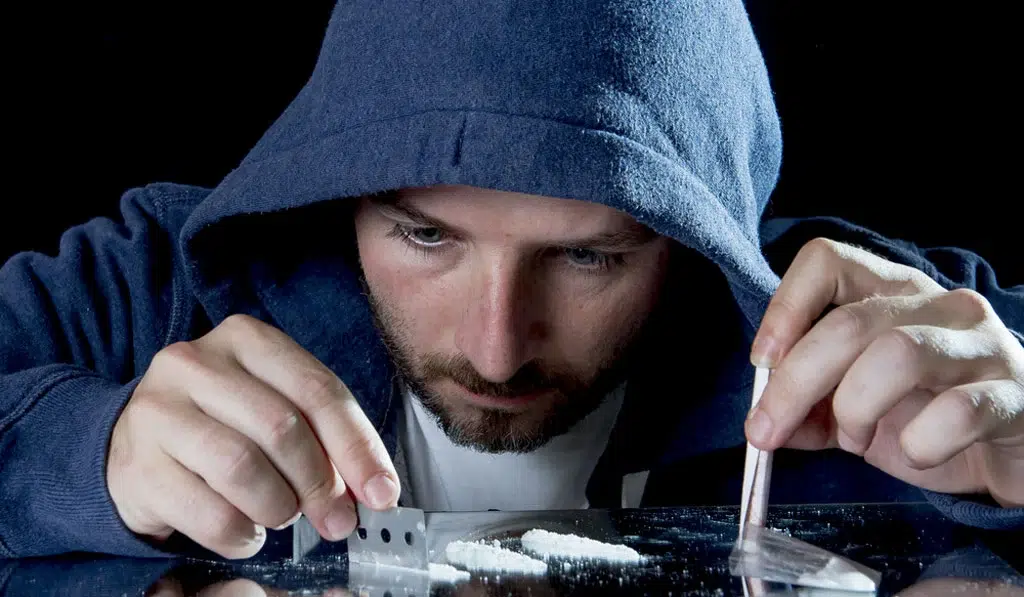Understanding Cocaine Addiction and Abuse
Table of Contents
Cocaine is a psychostimulant drug that produces a euphoric effect and alertness. It is the third most commonly used illicit substance in the United States and the second most abused illegal drug globally. Recent data suggests that about 2% of American adults use cocaine frequently, leading to a clear need for effective cocaine rehab offerings.
You may already know a lot about cocaine, enough to be concerned about its regular use in your life or that of a loved one. Primarily sold as a white powdery substance, cocaine reacts with the body’s central nervous system (CNS) to induce energy and a feeling of euphoria.
Cocaine is a highly addictive substance made from the South American coca plant leaves. It is classified as a Schedule II substance, highlighting its high potential for abuse and addiction.
Immediate Placement for Cocaine Addiction Treatment
Addiction to cocaine or other drugs can be damaging to the lives of the client, their family, and friends. However, with the right treatment and support, you can reclaim your life back from addiction and live a happy, healthy life.
If you or a loved one is battling addiction, keep reading to learn how to effect cocaine rehab at Emerald Isle Health and Recovery can help.
How do People Use Cocaine?
People use cocaine in many different ways. Initially, the drug was prescribed to patients suffering from medical conditions such as cholera and fatigue. Cocaine is still used in medical settings as cocaine hydrochloride, a topical anesthetic.
There aren’t many legitimate medical applications for cocaine, and most users start using the drug of their own volition. Non-medical use of cocaine is illegal, and the resulting underground markets for the drug are extremely dangerous.
The illegal cocaine formulations obtained on the street are often white powders of varying purities. Although most cocaine users snort the drug, there are four different ways that most people consume this drug:
- Snorting
- Smoking
- Injecting
- Swallowing
Snorting is the most popular route of administration. When snorted, the drug reaches the brain and triggers a powerful high within seconds. However, the high only lasts for a short time before the user starts to feel withdrawal effects.
Injecting cocaine is performed similarly to injecting heroin, and it carries many of the same health risks, including vein collapse and the spread of infectious diseases. Intravenous (IV) cocaine use is one of the most dangerous ways to use the drug, and it is responsible for many overdose-related emergency room admissions.
Cocaine vs Crack Cocaine
Cocaine can be smoked on its own, are pure cocaine, or as crack. Crack is made by combining cocaine with baking soda and smoking the resulting hard rock. When smoked in its purest form, known as “freebasing,” the high hits almost immediately and produces intense euphoria that can last for about half an hour.
Because crack is usually not as pure as freebase, its effects wear off more quickly, and its crash is more intense. Within minutes of finishing a dose, this can make a heavy user crave more of the drug.
Swallowing is the least common way to get cocaine into the bloodstream. Cocaine is typically ingested orally to reinforce or extend the effects of a previous dose, and this “boosting” can increase the user’s exposure to cocaine to potentially lethal levels.
Cocaine Slang or Street Names
Cocaine has many slang names, including:
- Coke
- Blow
- Snow
- Crack
- Rock
Cocaine Addiction Treatment
Cocaine is a highly potent drug that boosts dopamine levels in your body. Dopamine is the chemical in your brain that offers a sense of well-being. After repeated use, the body gets used to elevated dopamine levels, making you depressed if you don’t use the drug.
At this point, your body starts hinting that the dopamine levels need a boost. This leads to dependence and, eventually, cocaine use disorder or addiction.
If you or a loved one is suffering from cocaine addiction, our passionate team at Emerald Isle Health and Recovery will guide you through the various levels of treatment and the services offered at our facilities.
Cocaine Rehab: Levels of Care
Cocaine addiction treatment usually includes a blend of detox, behavioral therapies, and inpatient treatment. Drug abuse treatment programs usually consists of the following:
Medical Detox: Medically supervised detoxification is often the first step on the road to recovery from cocaine addiction. This can be done in various settings, including hospitals, clinics, or inpatient and outpatient facilities.
Residential and Inpatient Treatment: Clients in residential treatment programs have the safety and security of a facility monitored around the clock by medical professionals.
Partial Hospitalization Programs (PHP): When clients are admitted to a partial hospitalization program, they are granted greater freedom than they would in a residential facility. Clients who are driven to recover or have completed more intensive programs may benefit most from partial hospitalization programs.
Intensive Outpatient Programs (IOP): Clients participating in intensive outpatient programs can receive care throughout the day and return home at night. Clients who have already proven they do not require constant observation will do well in this setting.
Transitional Living: Many people find it helpful to stay in a sober environment after finishing an inpatient or outpatient program, where they can get support from peers and professionals who can help them find medical care, gainful employment, and other resources as they reintegrate into society.
24 Hour Cocaine Addiction Hotline
Therapies Used to Treat Cocaine Abuse
Substance use disorders (SUD) are complex, chronic diseases that need a holistic treatment approach tailored to individual client needs. Most treatment regimens use a blend of various proven techniques to help clients with recovery.
Cocaine addiction treatment usually begins with detoxification, which may last for about a week. However, detox is the first step in addiction treatment or cocaine rehab. Once clients complete detoxification, they can start recovery in a residential or outpatient facility.
The most essential aspect of cocaine or drug rehab is how long one stays in treatment. Drug addiction treatment programs usually last 30 to 90 days, but some clients may require long-term therapy based on their unique needs.
Although there are some pharmaceutical treatments for drug dependence, the primary treatment method for cocaine abuse is behavioral therapy. Doctors may prescribe some medications to help ease withdrawal symptoms.
According to the Substance Abuse and Mental Health Services Administration (SAMHSA), the following are the most effective therapies for treating cocaine abuse or addiction:
Motivational Interviewing
Motivational interviewing is often the first therapy stage for people starting to recover from addiction. Its primary goal is to get the patient to recognize how their addiction prevents them from achieving their goals and causing strain in their relationships. The strategy aims to inspire hope and motivation in patients who may otherwise feel hopeless about getting better.
Contingency Management
Stimulants are addictive because they take over the brain’s reward pathways, but contingency management can help restore normal functioning by reinforcing desirable actions. Under this technique, clients in rehab get rewarded for meeting attendance, medication compliance, and drug toxicity, which helps in overcoming cocaine addiction.
Community Reinforcement
Through the cultivation of a reassuring social network, community reinforcement highlights the patient’s demonstrated pro-health behaviors identified through contingency management. Community reinforcement could include strategies such as counseling for relationships, training for new jobs, or fun recreational activities.
Cognitive Behavioral Therapy (CBT)
Through CBT, patients can identify and avoid situations that could jeopardize their cocaine addiction recovery and replace negative thought patterns with more constructive ones. When it comes to mental health, people who are experiencing co-occurring disorders also benefit significantly from this cocaine treatment approach.
Cocaine addiction is a significant health issue that has far-reaching consequences on the mind and body. Cocaine users face severe health and social consequences, but they could also potentially face the stigma of addiction.
Addiction, however, is neither a moral failing nor a sign of personal weakness; instead, it is a complex medical disorder that can be effectively treated. Many formerly afflicted persons can now lead productive lives because of effective therapy.
What are the Typical Effects of Cocaine?
Cocaine is a stimulant, meaning it increases activity in the central nervous system and the body’s sympathetic nervous system. Cocaine gives the consumer a rush, which might manifest in elevated mood, increased productivity, and dynamism.
The drug’s short-term or initial effects include:
- A state of extreme joy and happiness; euphoria
- Dilated pupils
- Mental alertness
- Excess energy
- Being extremely talkative
Cocaine abuse has many negative consequences, such as:
- Paranoia
- Anxiety and irritability
- Light, sound, and touch sensitivity
- Reduced appetite
- Increased alertness
- Aggressive behaviors
- Constricted blood vessels
- Elevated or irregular heartbeat
- Nausea
- High body temperature and blood pressure
- Tremors and twitching of the muscles
There is a risk of repeated doses over several hours or even days because the high and short-term effects wear off quickly. Those who engage in cocaine abuse repeatedly often experience a “crash” after the impact of the drug wears off. This can manifest as feelings of exhaustion, anxiety, and depression.
Are there Dangers Associated with Cocaine Use?
Abusing cocaine in any of its forms can have devastating effects on health. Prolonged cocaine use may affect the heart and other vital organs. Examples of cardiovascular issues caused by cocaine include disruption in heart rhythm and heart attacks. Other problems associated with chronic cocaine abuse include heart muscle inflammation, a reduction in the heart’s ability to contract, and even a ruptured blood vessel.
Cocaine users could be undernourished. The drug decreases blood flow in the gastrointestinal tract, leading to ulcers and tears, and users sometimes overlook appropriate eating habits when on a binge.
Cocaine usage can also damage the kidneys and, in severe cases, even lead to renal failure. Below are other potentially fatal health risks of cocaine abuse:
- Impaired cognitive function, including poor motor skills, attention deficit, and memory loss
- Acute coronary syndrome
- Extreme high blood pressure
- Stroke
- Seizure
- Hyperthermia
Cocaine usage during pregnancy is equally harmful to the fetus. This psychostimulant increases heart rate and blood pressure. It also reduces blood flow to the uterus, depriving the fetus of oxygen.
Babies born to moms who use cocaine during pregnancy are more likely to have birth abnormalities, issues with the central nervous system, and even death.
24 Hour Addiction Treatment Hotline – Call Now!
Nasal damage from repeated cocaine snorting can lead to persistent bleeding, a perpetually stuffy nose, and even a loss of smell. “Crack lung,” which refers to the damage commonly inflicted upon the lung sacks by smoking crack cocaine, can cause breathing difficulties, fever, coughing up blood, and even respiratory collapse.
Because of the higher risk of overdose and the exposure to infectious diseases connected with needle drug use, intravenous cocaine administration is likely the riskiest way to take the drug. Skin abscesses, infections, endocarditis, HIV, and hepatitis are all common risks associated with injecting cocaine.
Get Help at an Accredited Cocaine Rehab Now
Cocaine addiction is very challenging to overcome, but it can be done. With our help and the foundation in recovery provided by our programs, hope is right around the corner.
Call Emerald Isle Health and Recovery at 855-613-0620 if you or a loved one needs help with a solid start in recovering from cocaine. All calls are totally confidential, so please give yourself the break you need and deserve – reach out now!




